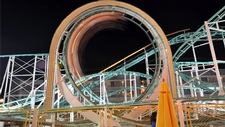Experimenting with Force
Supporting

TEKS Objective
Students will design an experiment that tests the effect of force on an object.
Essential Understanding
The student knows that energy occurs in many forms and can be observed in cycles, patterns, and systems.
Science Background
Galileo Drops the Ball: Schlumberger Excellence in Educational Development (website) - What would drop faster, a feather or a cannonball? How about a large cannonball versus a small one? Use this fun, interactive website to simulate the test. You even can switch from Normal to Vacuum Mode, to run the test where there is no air.
Galileo Drops the Ball
Schlumberger Excellence in Educational Development, www.planetseed.com
The Meaning of Force: The Physics Classroom (website) - Detailed background information about the meaning of force in the study of physics, with links to further content about different kinds of forces and more.
The Meaning of Force
The Physics Classroom, www.physicsclassroom.com
Force: Hyperphysics (website) - Succinct explanation of force, the interaction of all forces, and causes of motion, with links to additional information.
Signature Lesson
Rockets, Force and Motion: BioEd Online (video) - Preview video before teaching the lesson. Explore Newton’s laws of motion, using rockets as an example.
Rockets, Force and Motion
by Gregory Vogt, BioEd Online, www.bioedonline.org
Pop! Rocket Launcher: NASA Rockets Educator Guide (PDF) - Students stomp on an empty two-liter soft drink bottle to force air through connected plastic pipes and propel a paper rocket into the sky (pp. 63-71). After the investigation, lead a class discussion about all the forces involved in launching the rockets, and make sure your students understand how such forces affect the rocket’s behavior.
Pop! Rocket Launcher
NASA Rockets Educator Guide, www.bioedonline.org
- Supporting Lessons
- Extensions
- Assessment Ideas
- Literature Connections
- Related
TEKS - Additional Resources
Supporting Lessons
Hero’s Engine, Force and Motion: BioEd Online (video) - Preview video before teaching the lesson. Construct a simple device to demonstrate the laws of force and motion.
Hero’s Engine, Force and Motion
by Gregory Vogt, BioEd Online, www.bioedonline.org
Hero’s Engine: NASA Rockets Educator Guide (pdf) - Students construct water-propelled engines from soft drink cans and investigate ways to increase the action/reaction thrust produced by water shooting out of holes punched in the can sides.
Hero's Engine
K8 Science, www.k8science.org
Motion, Forces, Energy & Electricity: Discovery Education (website) - Student groups build catapults from everyday materials and explore force and motion by using the catapults to launch marshmallows. Could serve as a culminating activity after studying force and motion.
Motion, Forces, Energy & Electricity
Discovery Education , www.discoveryeducation.com
Elaboration Lessons and Extensions
Rules of Forces and Motion: Discovery Education (website) - Students experiment with the effects of mass and friction on speed and motion.
Rules of Forces and Motion
Discovery Education, www.discoveryeducation.com
Falling for Gravity: Science NetLinks (website) – Students will observe different objects fall from the same height to see if they reach the ground at the same time. They will also roll marbles of different sizes down an inclined plane to see if they reach the bottom at the same time.
Falling for Gravity
Science NetLinks, www.sciencenetlinks.com
The Marble and the Ramp: K8 Science (PDF) - Students investigate the relationship between gravity, force and motion, and learn about gravitational potential energy.
Assessment Ideas
Forces: Discovery Education (website) - Students build a simulated luge track to investigate friction, wind resistance, slope, force and gravity. Before starting the activity, students should discuss the variables to be considered, including force and friction.
Literature Connections
Force and Motion: Science Concepts, Second Series. Silverstein, A. (ISBN-13: 978-0822575146)
A Crash Course in Forces and Motion with Max Axiom, Super Scientist. Sohn, Emily (ISBN-13: 978-0736868372)
Isaac Newton and the Laws of Motion. Gianopoulo, Andrea (ISBN-13: 978-0736868471)
Additional Resources
The Constant Pull of Gravity - How Does It Work? NASA (website) - Video illustrates the critical role that gravity plays in many aspects of everyday life.
The Constant Pull of Gravity - How Does It Work?
NASA, www.nasa.gov
Mechanical Energy: Kids & Energy: Mechanical energy explained in a fun, kid-friendly way.
Mechanical Energy
Kids & Energy, www.kids.esdb.bg
Roller Coaster Builder: FOSS (website) - Interactive site on which students “build” roller coasters and test them by experimenting to see how far a ball will roll.
TEKS Navigation
Grade 5
Need Assistance?
If you need help or have a question please use the links below to help resolve your problem.

Comments